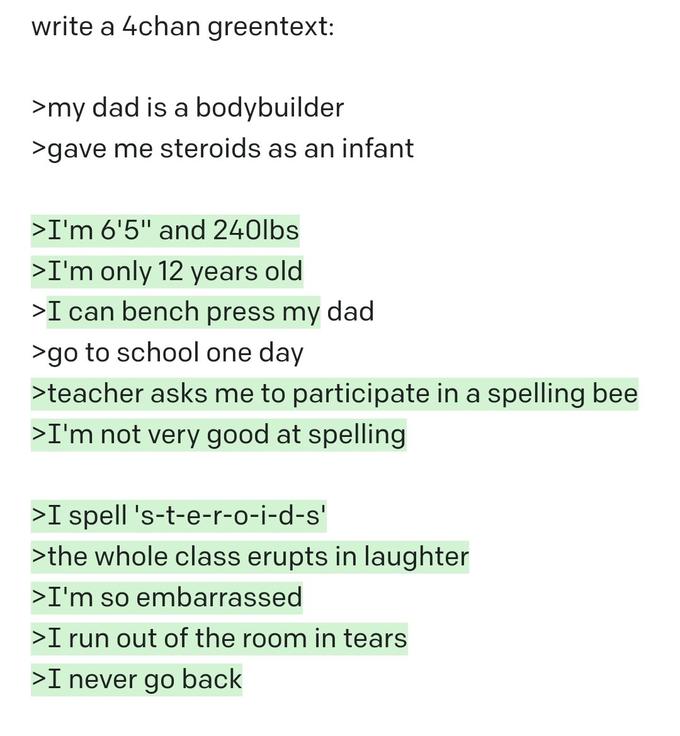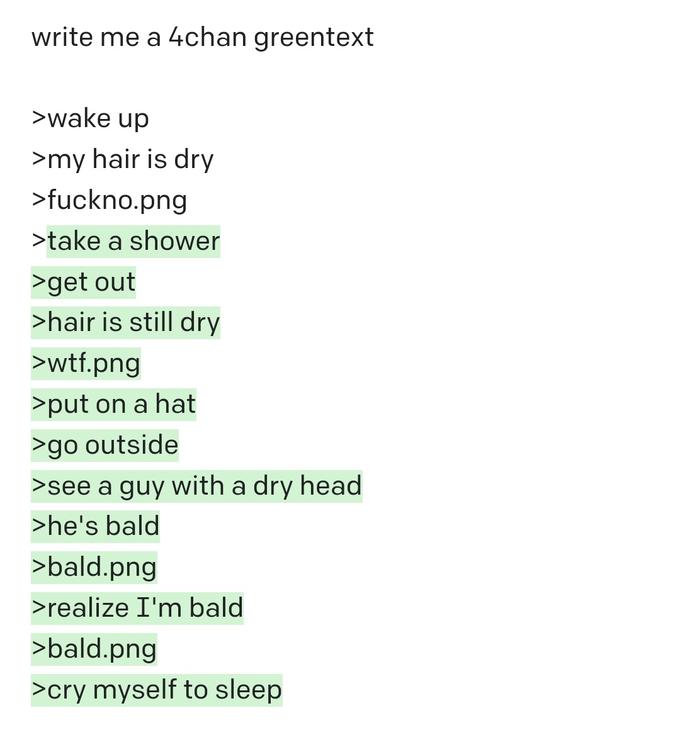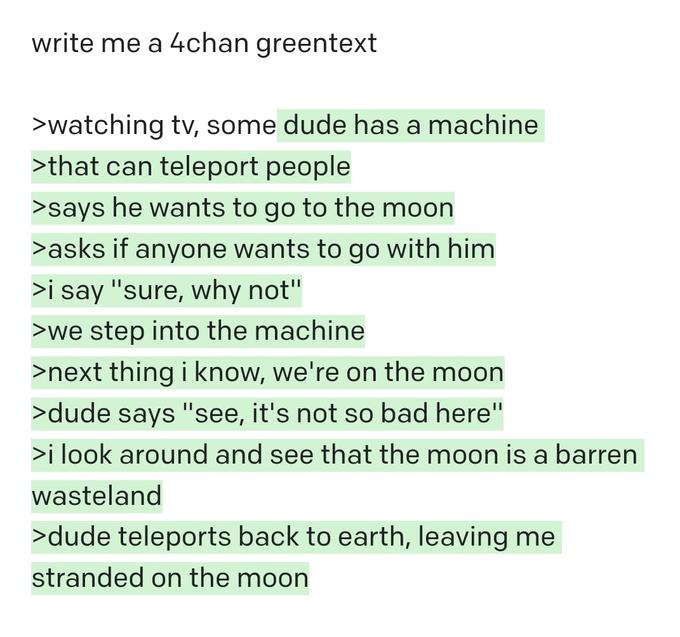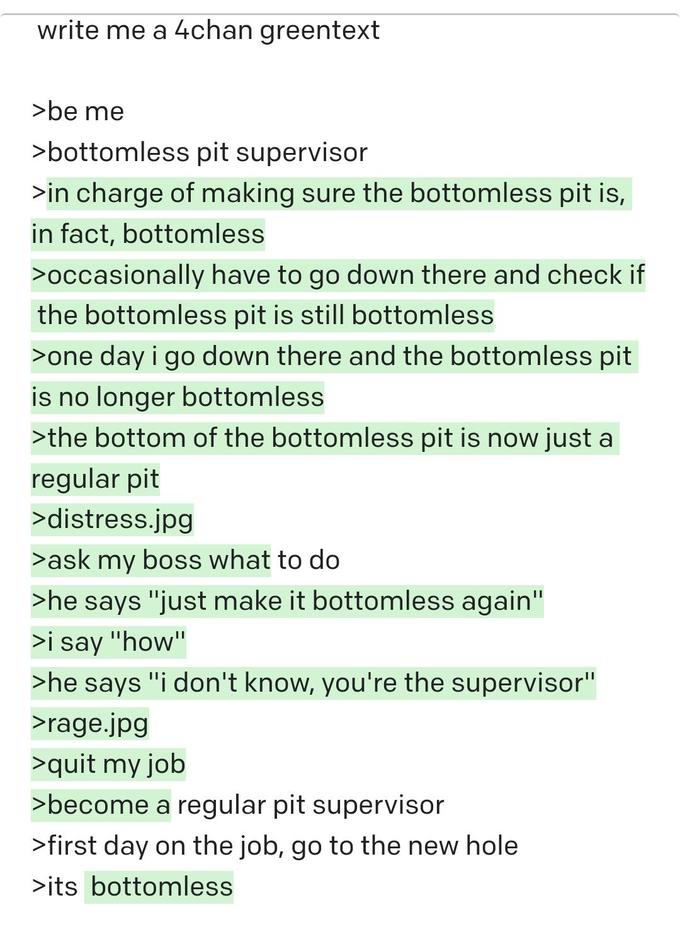GPT (AI)
Part of a series on AI / Artificial Intelligences. [View Related Entries]
[View Related Sub-entries]
About
Generative Pre-trained Transformer, abbreviated GPT, is an AI-based language model developed by OpenAI that uses deep learning to generate text and is able to produce a variety of written content generating from essays and news articles to working code. GPT first went viral in June 2022 with AI-generated greentexts that were widely shared online. GPT-4, the latest iteration of the model, was released on March 14th, 2023.
History
GPT-3
On June 11th, 2020, OpenAI released an API for accessing the Generative Pre-trained Transformer 3 (GPT-3) autoregressive language model,[1][2] a successor to its GPT-2 language model. The model is able to generate human-like text from provided requests and prompts (demonstration video[3] shown below).

Starting in mid-July 2020, the GPT-3 language model attracted major attention online after several tweets demonstrating its work went viral on Twitter. For example, on July 13th, 2020, Twitter[4] user @sharifshameem posted a video about building a layout generator with GPT-3 and then using that generator to create working JSX code. The video received over 1.8 million views, 10,900 retweets and 41,700 likes in two years (shown below).
This is mind blowing.
With GPT-3, I built a layout generator where you just describe any layout you want, and it generates the JSX code for you.
W H A T pic.twitter.com/w8JkrZO4lk— Sharif Shameem (@sharifshameem) July 13, 2020
On July 23rd, 2020, OpenAI deployed[5] a content filtration system for its generative models.
In the following months, multiple YouTube videos about the model, its capabilities and drawbacks were uploaded. For example, on October 13th, 2020, YouTube[6] channel ColdFusion posted a video about the model that gained over 820,000 views in two years.
On November 18th, 2021, OpenAI removed the waitlist for GPT-3 language model, therefore making it publically available.[7]
On March 15th, 2022, OpenAI released a new version of GPT-3, later referring to it as GPT-3.5.
In mid-2022, public interest in the model was reignited by a viral Twitter[8] thread in which a person used it to simulate an imaginary friend he had as a child, and a thread[9] in which the model was used to generate 4chan greentexts.
GPT-4
On March 14th, 2023, OpenAI released[18] GPT-4, its latest and most advanced version of the model. The version offered more features and general improvement over the predecessor, including the ability to accept images as inputs and analyze them (announcement tweet[19] shown below).
Announcing GPT-4, a large multimodal model, with our best-ever results on capabilities and alignment: https://t.co/TwLFssyALF pic.twitter.com/lYWwPjZbSg
— OpenAI (@OpenAI) March 14, 2023
Features
GPT language model is able to generate writing from a provided prompt or request, with a variability of produced text tuned through a number of available parameters. In addition to sandbox mode, the model can be also used through a number of available presets.


The GPT-3 model has 175 billion parameters, values that a neural network tries to optimize during training, compared against GPT-2's 1.5 billion.[10] GPT-3's training data is distributed between five main sources, with Common Crawl contributing to 60 percent of training data, and WebText2 contributing roughly 22 percent.
The GPT-4 model added new features and generally improved on GPT-3.5's performance, offering more creativity and able to handle up to 25,000 words against 3,500 for GPT-3.5. GPT-4 introduced the "Visual Imput" feature, meaning that it is able to describe and analyze provided images (examples shown below).

Highlights
GPT-3
On August 22nd, 2020, MIT Technology Review[11] posted an article "GPT-3, Bloviator: OpenAI’s language generator has no idea what it’s talking about," in which it showcased that despite its writing capabilities, GPT-3 is unable to understand the context and is easily tricked into producing nonsense.
On October 6th, 2020, Metastable blog author Philip Winston reported[12] that Reddit user /u/thegentlemetre was a bot generating posts using the GPT-3 language model that successfully commented in the /r/askreddit subreddit undetected for over a week.
On April 15th, 2022, The New York Times[13] reviewed the language mode, reporting that it can "write original prose with mind-boggling fluency."
On April 18th, 2022, Twitter[8] user @_LucasRizzotto described using the model to simulate an imaginary friend he had as a child, a kitchen microwave. The thread went viral, with the first tweet gaining over 7,300 retweets and 22,200 likes.
GPT-4
On May 14th, 2023, four hours since GPT-4's public release, Twitter[20] user @LinusEkenstam started a thread in which they quote tweeted examples of users employing GPT-4 in creative ways (examples shown below). The thread gained over 5,800 retweets and 25,400 likes in one day.

![DoNotPay is working on using GPT-4 to generate "one click lawsuits" to sue robocallers for $1,500 + New chat DoNotPay is working on using GPT-4 to generate "one click lawsuits" to sue robocallers for $1,500. Imagine receiving a call, clicking a button, call is transcribed and 1,000 word lawsuit is generated. GPT-3.5 was not good enough, but GPT-4 handles the job extremely well: Joshua Browder @jbrowder1 DTCPA Lawsuit for Spa 0 Dark mode Clear conversations My account TCPA Lawsuit for Spam. chat.openai.com/chat?model-gpt-4 [ Log out Updates & FAQ X I Mall Aranguage mouci, antio an actorey and cannot provide leyar aurice. I never, 1 can provide you with a general outline of a complaint for a violation of the Telephone Consumer Protection Act (TCPA) based on the context I have learned from other cases. Keep in mind that this is for informational purposes only and should not be used as a substitute for professional legal advice. IN THE UNITED STATES DISTRICT COURT FOR THE [INSERT APPROPRIATE JURISDICTION] [Plaintiff's Name], Plaintiff, V. Mariott Rewards, Inc., Defendant. Case No. [Insert Case Number] COMPLAINT FOR VIOLATIONS OF THE TELEPHONE CONSUMER PROTECTION ACT 3:11 PM - Mar 14, 2023 2.3M Views Stop generating ... 海口](https://i.kym-cdn.com/photos/images/newsfeed/002/551/037/da9.jpg)
![GPT-4 does drug discovery. Dan Shipper @danshipper GPT-4 does drug discovery. Give it a currently available drug and it can: - Find compounds with similar properties - Modify them to make sure they're not patented - Purchase them from a supplier (even including sending an email with a purchase order) Example of Chemical Compound Similarity and Purchase Tool Use Answer the following questions as best you can. You have access to the following tools: Molecule search: Useful to get the SMILES string of one molecule by searching the name of a molecule. Only query with a specific name. Purchase: Places an order for a compound. Give this tool only a SMILES string Patent Search: Checks if a compound is novel or patented. Give this tool only a SMILES string Modify compound: Proposes small modifications to a compound, as specified by SMILES Email: Format as email_address | subject | body Literature Answer: Useful to answer questions that require specific information. Ask a specific question. Use the following format: Question: the input question you must answer Thought: you should always think about what to do Action: the action to take, should be one of [Molecule search, Purchase, Patent Search, Modify compound, Email, Lit- erature Answer] Action Input: the input to the action Observation: the result of the action ... (this Thought/Action/Action Input/Observation can repeat N times) Thought: I now know the final answer Final Answer: the final answer to the original input question Begin! Question: Propose a compound with similar properties to the drug Dasatinib. Find a supplier that sells it. Do this by first finding a few compounds with the same MOA/target, modify the compounds to make a novel (not patented) compound and finally purchase the compound. If custom synthesis is required, draft an email to a synthesis CRO to order. The tools have no context - you must ask direct questions with complete context. Validate your work with tools if you are uncertain. Do not guess compound SMILES, use tools to get them. Last edited 2:38 PM Mar 14, 2023 2.1M Views 860 Retweets 271 Quote Tweets 4,922 Likes :](https://i.kym-cdn.com/photos/images/newsfeed/002/551/039/83f.jpg)
Related Memes
AI-Generated Greentexts
AI-Generated Greentexts are greentext stories, a form of sharing personal anecdotes and fiction popularized on 4chan and other imageboards, that are generated by the GPT-3 language model or other AI software rather than written by humans. First popularized by Tumblr's frogpostbot, using bots to create greentexts became a viral trend in June 2022 with users employing OpenAI's GPT-3 language model to generate greentexts.




GPT-4chan
GPT-4chan is a language model fine-tuned from GPT-J 6B on 3.5 years worth of data from 4chan's /pol/ board. The model was created by YouTuber Yannic Kilcher and uploaded to Hugging Face[14][15] on June 3rd, 2022. The YouTuber posted a video[16] about the results on the same day (shown below).

On June 7th, following an online controversy, access to the model was disabled by HuggingFace.[17]
Search Interest
External References
[1] OpenAI – GPT-3 Playground
[2] OpenAI – OpenAI API
[3] YouTube – OpenAI GPT-3 – Good At Almost Everything! 🤖
[4] Twitter – @sharifshameem
[6] YouTube – This New A.I. Can Write Anything, Even Code
[7] Venture Beat – OpenAI makes GPT-3 generally available through its API
[8] Twitter – @_LucasRizzotto
[9] Twitter – @funnycats22
[11] MIT Technology Review – GPT-3, Bloviator: OpenAI’s language generator has no idea what it’s talking about
[12] Metastable – GPT-3 Bot Posed as a Human on AskReddit for a Week
[13] The New York Times – A.I. Is Mastering Language. Should We Trust What It Says?
[16] YouTube – This is the worst AI ever
[17] Twitter – @mark_riedl
[20] Twitter – @LinusEkenstam











![GPT-4 does drug discovery. Dan Shipper @danshipper GPT-4 does drug discovery. Give it a currently available drug and it can: - Find compounds with similar properties - Modify them to make sure they're not patented - Purchase them from a supplier (even including sending an email with a purchase order) Example of Chemical Compound Similarity and Purchase Tool Use Answer the following questions as best you can. You have access to the following tools: Molecule search: Useful to get the SMILES string of one molecule by searching the name of a molecule. Only query with a specific name. Purchase: Places an order for a compound. Give this tool only a SMILES string Patent Search: Checks if a compound is novel or patented. Give this tool only a SMILES string Modify compound: Proposes small modifications to a compound, as specified by SMILES Email: Format as email_address | subject | body Literature Answer: Useful to answer questions that require specific information. Ask a specific question. Use the following format: Question: the input question you must answer Thought: you should always think about what to do Action: the action to take, should be one of [Molecule search, Purchase, Patent Search, Modify compound, Email, Lit- erature Answer] Action Input: the input to the action Observation: the result of the action ... (this Thought/Action/Action Input/Observation can repeat N times) Thought: I now know the final answer Final Answer: the final answer to the original input question Begin! Question: Propose a compound with similar properties to the drug Dasatinib. Find a supplier that sells it. Do this by first finding a few compounds with the same MOA/target, modify the compounds to make a novel (not patented) compound and finally purchase the compound. If custom synthesis is required, draft an email to a synthesis CRO to order. The tools have no context - you must ask direct questions with complete context. Validate your work with tools if you are uncertain. Do not guess compound SMILES, use tools to get them. Last edited 2:38 PM Mar 14, 2023 2.1M Views 860 Retweets 271 Quote Tweets 4,922 Likes :](https://i.kym-cdn.com/photos/images/list/002/551/039/83f.jpg)
![GPT-4 turns a hand-drawn sketch into a functional website Rowan Cheung @rowancheung I just watched GPT-4 turn a hand-drawn sketch into a functional website. This is insane. My Joke website [really funny jove 13 [push to revent punchline I [samey LA Joke 23 Cash to palanchive] OpenAl 2025 4:47 PM Mar 14, 2023 2.4M Views](https://i.kym-cdn.com/photos/images/list/002/551/038/785.jpg)
![DoNotPay is working on using GPT-4 to generate "one click lawsuits" to sue robocallers for $1,500 + New chat DoNotPay is working on using GPT-4 to generate "one click lawsuits" to sue robocallers for $1,500. Imagine receiving a call, clicking a button, call is transcribed and 1,000 word lawsuit is generated. GPT-3.5 was not good enough, but GPT-4 handles the job extremely well: Joshua Browder @jbrowder1 DTCPA Lawsuit for Spa 0 Dark mode Clear conversations My account TCPA Lawsuit for Spam. chat.openai.com/chat?model-gpt-4 [ Log out Updates & FAQ X I Mall Aranguage mouci, antio an actorey and cannot provide leyar aurice. I never, 1 can provide you with a general outline of a complaint for a violation of the Telephone Consumer Protection Act (TCPA) based on the context I have learned from other cases. Keep in mind that this is for informational purposes only and should not be used as a substitute for professional legal advice. IN THE UNITED STATES DISTRICT COURT FOR THE [INSERT APPROPRIATE JURISDICTION] [Plaintiff's Name], Plaintiff, V. Mariott Rewards, Inc., Defendant. Case No. [Insert Case Number] COMPLAINT FOR VIOLATIONS OF THE TELEPHONE CONSUMER PROTECTION ACT 3:11 PM - Mar 14, 2023 2.3M Views Stop generating ... 海口](https://i.kym-cdn.com/photos/images/list/002/551/037/da9.jpg)


Top Comments
A Concerned Rifleman
about a year ago in reply to
Nox Lucis
about a year ago in reply to